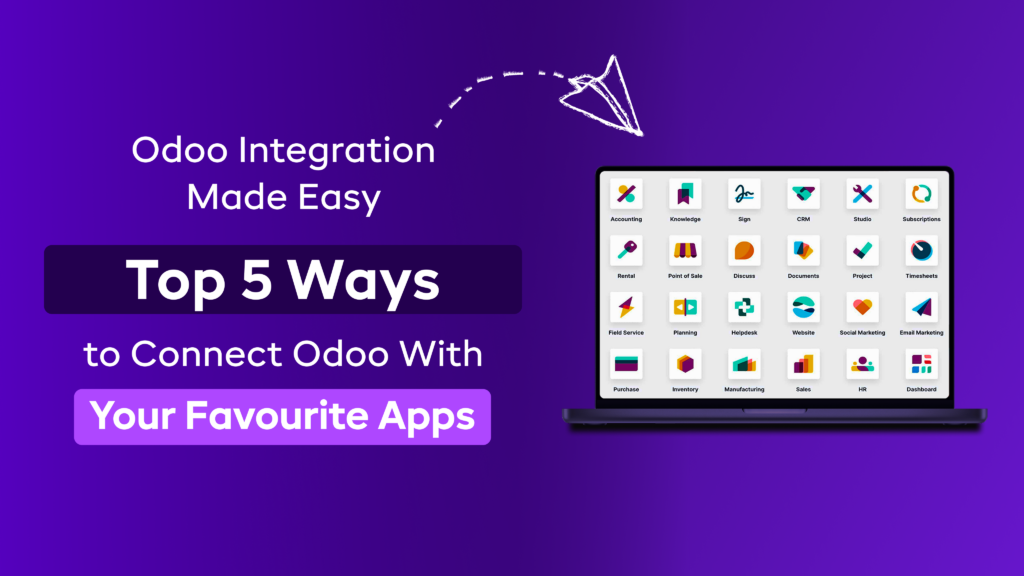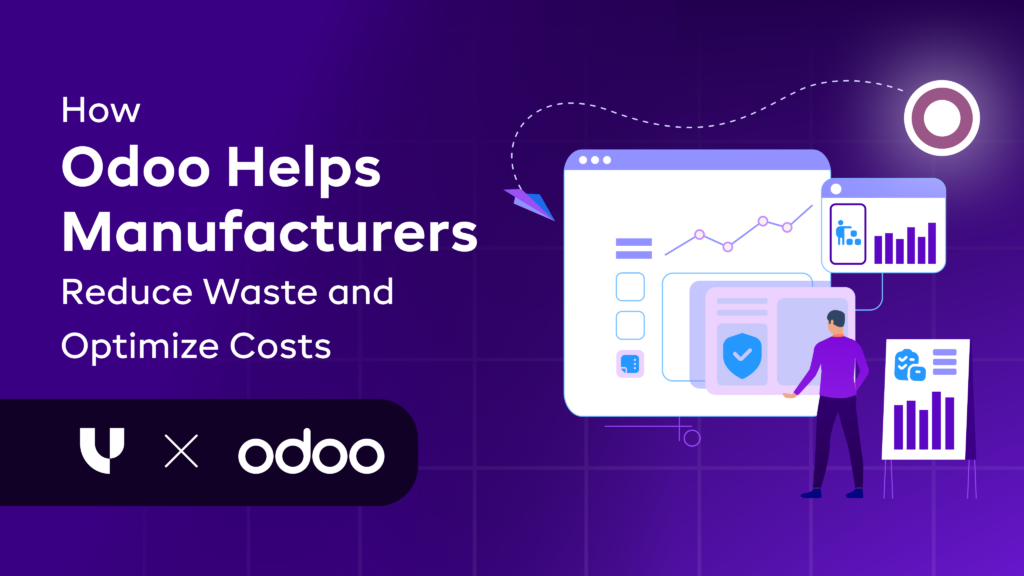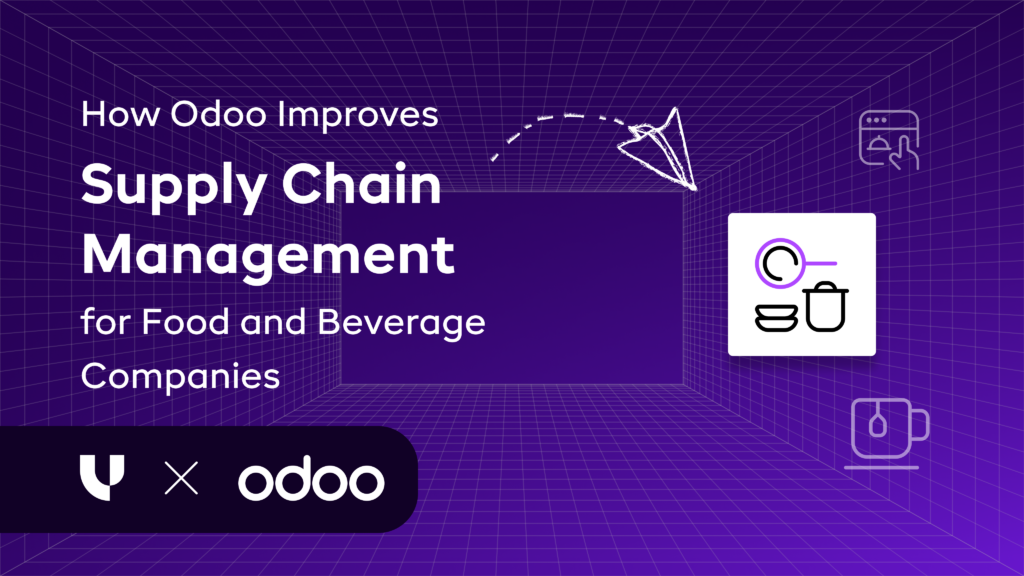Odoo Integration Made Easy: Top 5 Ways to Connect Odoo With Your Favourite Apps Odoo
Published on July 16th 2025

Introduction
The ease of integrating third-party applications in Odoo is by far one of its most significant selling points.
Customers find it convenient to integrate their software and applications over an intuitive platform and offer better services for their customers. Additionally, integrating Odoo with the company's favourite apps can streamline a lot of factors, namely:
- Automate repetitive tasks
- Improve communication between departments or teams
- Reduce errors
Additionally, users can also create a seamless workflow through additional Odoo apps.
Therefore, it’s essential to understand how to connect Odoo with your favorite apps. So, continue reading as we learn more about it in the following sections.
When assessing ERP platforms, integration capabilities are a critical factor. Our guide on how to choose an ERP systemwalks you through evaluating integration needs along with other key decision-making factors.
Understanding how platform compatibility influences your business scalability is key—our Odoo vs Salesforce detailed reviewbreaks down which solution adapts better to evolving integration needs.
Top 5 Ways to Connect Odoo With Your Favorite Apps
#1 Odoo Amazon Connector
Looking back at Odoo 17, one of the most notable announcements was Odoo's connection with Amazon. The platform now offers a native integration that brings Amazon marketplace management directly into your Odoo backend.
While the latest integration was introduced during the Odoo Experience keynote, this connector allows sellers to manage their Amazon listings, inventory, and orders, all without ever leaving Odoo.
You can simplify your multichannel strategy and create a truly unified commerce experience.
The connector supports a wide range of features, including:
- Automatic import of Amazon orders into Odoo
- Real-time inventory sync between Odoo and Amazon
- Auto-matching of Amazon products with Odoo SKUs
- Price synchronization for selected listings
- Fulfillment tracking and status updates
- Marketplace support for Amazon US, EU, and more
- Error log visibility and reconciliation
- Seamless invoicing and accounting integration
Having a built-in functionality allows your sales, logistics, and finance teams all operate from a single source of truth. Whether you’re fulfilling through Amazon FBA or your own warehouse, the connector ensures consistency, visibility, and automation.
Selling on Amazon no longer needs to be a siloed process. Instead, Odoo turns it into a fully connected workflow.
If you’re new to selling on Amazon, it’s the world’s largest online marketplace, handling millions of transactions daily. With the Odoo connector, even smaller sellers can plug into this ecosystem with enterprise-grade tools, no patchwork required.
Want to scale with Amazon? Odoo just made it easier.
#2 Odoo Shopify Connector
Shopify is a platform utilized by enterprises worldwide.
The Odoo Shopify Connector App is the most user-friendly choice. It can provide several benefits to users or clients as a stopgap before moving everything in-house for Odoo:
- Streamline Order Management: By combining Odoo with Shopify, you can quickly handle orders, shipping, and returns from one spot. You may also monitor the status of orders, manage inventories, and change product information in real time.
- Sync Customer Information: Integrating Odoo with Shopify allows you to sync customer data across the two systems. This implies that client information such as names, addresses, and order history may be freely accessed across both platforms.
- Centralized Product Information: By combining Odoo with Shopify, you can centralize product information across both platforms. This allows you to easily change product information, such as descriptions, price, and inventory levels, while guaranteeing consistency across all channels.
Integrating Odoo with Shopify can help companies streamline accounting and finance procedures. You can automatically generate invoices, track payments, and reconcile accounts. This can help you save time and reduce mistakes.
#3 Odoo eCommerce Connector
eCommerce is shaping the world around us and it’s not doubt that it has found its way to the Odoo platform. Thanks to its growing prevalence, users can now integrate eComm operations into their everyday workflow over a few clicks.
The connector allows business owners to streamline their operations with:
Real-time sync of products, prices, and stock levels
Update a product once in Odoo and have it reflected instantly across your connected store(s). This way, you have a first-hand idea of the running inventory.Automatic order import and customer data capture
Every sale made online appears in Odoo with full customer, product, and payment details. Having updated order status helps you stand ahead in planning operations.Streamlined fulfillment and shipping integration
Orders move seamlessly into Odoo's delivery workflows, with tracking and invoicing handled automatically.Unified analytics
Monitor performance across sales channels from one place, no fragmented reports or blind spots. This way, you can easily examine your data for better operations.Cart abandonment recovery & marketing automation
Use Odoo’s CRM and marketing tools to follow up with leads and convert more browsers into buyers.Whether you're managing a single storefront or selling across multiple platforms and regions, this connector acts as the glue that binds it all together.
And the best part? You can continue using your preferred front-end store while relying on Odoo to manage inventory, accounting, logistics, customer service, and marketing.
It’s an all-in-one solution for businesses that want growth without chaos.
#4 Odoo WooCommerce Integration
When talking of online platforms, you can’t miss out on WooCommerce, the leading giant for businesses moving to the eCommerce sector. Thanks to Odoo’s latest WooCommerce integration, now every user can bridge the gap in their operations using the powerful backend.
The Odoo WooCommerce Connector acts as a powerful integration bridge between your WooCommerce storefront and Odoo’s ERP system. It ensures real-time data synchronization across critical business functions such as sales, inventory, accounting, and logistics, helping you eliminate manual work and improve accuracy.
Wonder how WooCommerce integration aids your business? Let’s find out:
a. Product Synchronization
Push product details from Odoo to WooCommerce seamlessly. This includes product names, descriptions, SKUs, images, stock levels, pricing (including discounts), and product variants like size or color. This ensures consistency across platforms and reduces duplicate data entry.b. Real-Time Inventory Updates
As orders are placed, received, or fulfilled, Odoo updates your stock levels automatically on WooCommerce. This minimizes overselling risks and helps maintain accurate availability on your storefront.c. Order Import and Status Sync
Customer orders placed in WooCommerce are automatically imported into Odoo as sales orders. Key details, such as shipping method, customer information, taxes, and payment status are captured. Order updates like shipping or invoicing are then pushed back to WooCommerce in real time.d. Customer Data Synchronization
Customer contact details, billing addresses, and shipping information are kept in sync between both systems. This helps streamline marketing campaigns, CRM activities, and customer service workflows.e. Shipping and Fulfillment
Use Odoo to generate delivery orders, assign shipping methods, and manage fulfillment processes. You can also integrate with Odoo’s shipping carriers to print labels, provide tracking, and confirm deliveries.f. Financial Integration
Sales transactions from WooCommerce are reflected in Odoo Accounting, simplifying invoicing, reconciliation, and financial reporting. Taxes, discounts, and payment gateway details are all accounted for automatically.With WooCommerce integration, you no longer need to switch between platforms, export spreadsheets, or worry about syncing errors. This connector centralizes your business so your sales, warehouse, and accounting teams always stay on the same page.
#5 Odoo and eBay
eBay is a prominent online marketplace with millions of active buyers and sellers for people who have never used it before. Integrating with Odoo ERP and eBay may bring various benefits to your e-commerce firm, including:
- Inventory Control: Odoo has complete inventory management capabilities that allow you to track and control inventory levels in real time. Odoo ERP, when coupled with eBay, can instantly update inventory levels across all sales channels, including eBay, guaranteeing proper inventory control and reducing overselling.
- Centralized Order Management: With the Odoo eBay connection, all of your eBay orders will be instantly synchronized with your Odoo ERP system, allowing you to manage all of your orders from a single spot. You can track orders, adjust statuses, and process orders more effectively, lowering the possibility of mistakes and delays.
- Product Listing Management: Adding items on eBay may be time-consuming and frustrating. Odoo eBay connection allows you to simply manage your product listings from within your Odoo ERP system. You may use Odoo ERP to create, edit, and remove product listings, manage product details, and synchronize product data with eBay, saving you time and effort.
- Streamlined Order Fulfilment: Odoo ERP provides comprehensive order fulfilment services, including packaging, shipping, and tracking. When combined with eBay, Odoo ERP can automatically print shipping labels, update order status with tracking information, and automate the entire order fulfillment process, saving you time and eliminating manual mistakes.
Want to start a project with us?
Empowering businesses to achieve greatness through strategic guidance and innovative solutions.
Book A Demo
Conclusion
Let’s face it, managing different customizations can be a handful if you don’t understand the process. Therefore, it’s best to trust professional Odoo marketplace integration services like Uncanny to get the best integrations for your operations.

About Author


